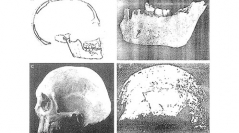

 Comptes Rendus Palevol
5 (1-2) - Pages 353-357
Comptes Rendus Palevol
5 (1-2) - Pages 353-357Tracing continuity of evolving humans with the aid of their scanty skeletal remains is an intricate puzzle. In the specific case of Indian sub-continent, the so-far oldest human ancestor, the Narmada hominid, has wider spatial distance both from the antecedents on one side and the descendents on the other side. Ramapithecus, a geographically closely located primate earlier considered of hominidae affinity, is now far out of human lineage. Distance to the nearest possible Homo erectus remains for Southeast and East Asia and the westward located Levantine, African and European remains are no less than exorbitant three to four thousand kilometres from the Hathnora fossil locality. The nearest possible 25 000–30 000-year-old descendents of Batadombalena (Sri Lanka), Darra-i-Kur (Afghanistan), Kurnool District caves, or even younger Bhimbetka, Sarai Nahar, Mahadaha, Lothal, Dholavira of 4000–10 000-year-old antiquity are closely located (Fig. 1). A possible hierarchical relationship is attempted.
Homo erectus , Modern Indian, Narmada, India